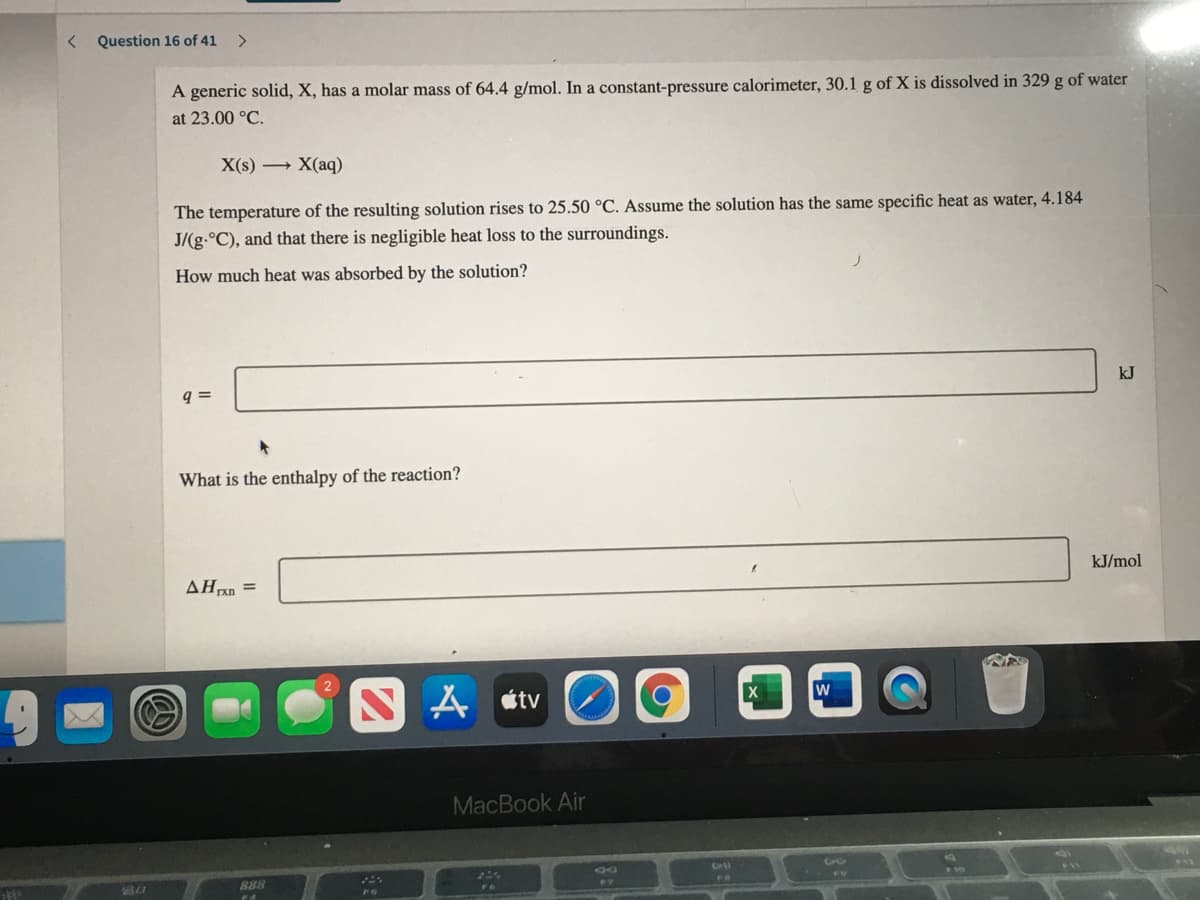A generic solid, X, has a molar mass of 64.4 g/mol. In a constant-pressure calorimeter, 30.1 g of X is dissolved in 329 g of water at 23.00 °C. X(s) X(aq) The temperature of the resulting solution rises to 25.50 °C. Assume the solution has the same specific heat as water, 4.184 J/(g.°C), and that there is negligible heat loss to the surroundings. How much heat was absorbed by the solution? kJ q = What is the enthalpy of the reaction? kJ/mol AHan =
A generic solid, X, has a molar mass of 64.4 g/mol. In a constant-pressure calorimeter, 30.1 g of X is dissolved in 329 g of water at 23.00 °C. X(s) X(aq) The temperature of the resulting solution rises to 25.50 °C. Assume the solution has the same specific heat as water, 4.184 J/(g.°C), and that there is negligible heat loss to the surroundings. How much heat was absorbed by the solution? kJ q = What is the enthalpy of the reaction? kJ/mol AHan =
Chemistry: Principles and Practice
3rd Edition
ISBN:9780534420123
Author:Daniel L. Reger, Scott R. Goode, David W. Ball, Edward Mercer
Publisher:Daniel L. Reger, Scott R. Goode, David W. Ball, Edward Mercer
Chapter5: Thermochemistry
Section: Chapter Questions
Problem 5.62QE: A 50-mL solution of a dilute AgNO3 solution is added to 100 mL of a base solution in a coffee-cup...
Related questions
Question

Transcribed Image Text:< Question 16 of 41
<>
A generic solid, X, has a molar mass of 64.4 g/mol. In a constant-pressure calorimeter, 30.1 g of X is dissolved in 329 g of water
at 23.00 °C.
X(s) → X(aq)
The temperature of the resulting solution rises to 25.50 °C. Assume the solution has the same specific heat as water, 4.184
J/(g.°C), and that there is negligible heat loss to the surroundings.
How much heat was absorbed by the solution?
kJ
q =
What is the enthalpy of the reaction?
kJ/mol
AHxn =
N A «tv
MacBook Air
888
Expert Solution
This question has been solved!
Explore an expertly crafted, step-by-step solution for a thorough understanding of key concepts.
This is a popular solution!
Trending now
This is a popular solution!
Step by step
Solved in 3 steps with 1 images

Knowledge Booster
Learn more about
Need a deep-dive on the concept behind this application? Look no further. Learn more about this topic, chemistry and related others by exploring similar questions and additional content below.Recommended textbooks for you

Chemistry: Principles and Practice
Chemistry
ISBN:
9780534420123
Author:
Daniel L. Reger, Scott R. Goode, David W. Ball, Edward Mercer
Publisher:
Cengage Learning

Chemistry: An Atoms First Approach
Chemistry
ISBN:
9781305079243
Author:
Steven S. Zumdahl, Susan A. Zumdahl
Publisher:
Cengage Learning

Chemistry
Chemistry
ISBN:
9781305957404
Author:
Steven S. Zumdahl, Susan A. Zumdahl, Donald J. DeCoste
Publisher:
Cengage Learning

Chemistry: Principles and Practice
Chemistry
ISBN:
9780534420123
Author:
Daniel L. Reger, Scott R. Goode, David W. Ball, Edward Mercer
Publisher:
Cengage Learning

Chemistry: An Atoms First Approach
Chemistry
ISBN:
9781305079243
Author:
Steven S. Zumdahl, Susan A. Zumdahl
Publisher:
Cengage Learning

Chemistry
Chemistry
ISBN:
9781305957404
Author:
Steven S. Zumdahl, Susan A. Zumdahl, Donald J. DeCoste
Publisher:
Cengage Learning


Chemistry: Principles and Reactions
Chemistry
ISBN:
9781305079373
Author:
William L. Masterton, Cecile N. Hurley
Publisher:
Cengage Learning

General Chemistry - Standalone book (MindTap Cour…
Chemistry
ISBN:
9781305580343
Author:
Steven D. Gammon, Ebbing, Darrell Ebbing, Steven D., Darrell; Gammon, Darrell Ebbing; Steven D. Gammon, Darrell D.; Gammon, Ebbing; Steven D. Gammon; Darrell
Publisher:
Cengage Learning